Current Trends Update: Trends in AIDS Diagnosis and Reporting Under the Expanded Surveillance Definition for Adolescents and Adults - United States, 1993
MMWR Volume 43, Issue 45, pages 826-831
Publication date: 11/18/1994
Table of Contents
Article
November 18, 1994 / 43(45);826-831
Current Trends Update: Trends in AIDS Diagnosis and Reporting Under the Expanded Surveillance Definition for Adolescents and Adults -- United States, 1993The expansion of the surveillance case definition for acquired immunodeficiency syndrome (AIDS) in January 1993 (1) resulted in a large increase in reported AIDS cases. This increase has primarily reflected reports of human immunodeficiency virus (HIV)-infected persons in whom severe immunosuppression (CD4+ count less than 200 T- lymphocytes/uL or a CD4+ T-lymphocyte percentage of total lymphocytes of less than 14) had been diagnosed, which typically occurs before the onset of AIDS-defining opportunistic illnesses (AIDS-OIs, CDC clinical category C disease) (1,2). The inclusion of the CD4+ reporting criteria in AIDS surveillance has required an alteration in methods used to assess trends in AIDS incidence, previously based on the diagnosis of AIDS-OIs. This report first summarizes information about AIDS cases reported during 1993; then, to describe trends in AIDS incidence if the surveillance definition had not been expanded, this report uses estimates of eventual AIDS-OI diagnosis dates for persons who were reported with AIDS based only on the CD4+ criteria. * Trends in AIDS by Date of Report In 1993, a total of 105,990 AIDS cases were reported among adolescents and adults in the United States (2). Of 56,400 AIDS case reports based on any of the new reporting criteria (which include the CD4+ criteria, pulmonary tuberculosis, recurrent pneumonia, and invasive cervical cancer), 50,800 (90%) were based on the CD4+ reporting criteria; cases meeting the CD4+ criteria represented 48% of the 105,990 total AIDS cases reported. The number of AIDS cases reported quarterly in 1993 ranged from 36,290 cases (first quarter) to 18,360 cases (fourth quarter) Figure_1. Trends in AIDS-OIs by Date of Diagnosis Estimating AIDS incidence based on the 1993 definition in a manner consistent with the definition used in previous years requires estimating when persons who were reported using the CD4+ criteria would develop AIDS-OIs. The probability distribution of the duration from the occurrence of a specific CD4+ count to the onset of the first AIDS-OI among HIV-infected persons was estimated using data from the CDC-sponsored Adult/Adolescent Spectrum of Disease Project (4). The estimated median time until development of an AIDS-OI for these persons was 19 months. The estimated AIDS-OI incidence is the sum of the observed AIDS-OI incidence and the incidence based on estimated dates of diagnosis for persons reported with AIDS based only on the CD4+ criteria; both incidences were adjusted for reporting delays. In 1993, the incidence of AIDS-OIs was estimated to have been 62,000 cases, approximately 15,000 cases each quarter Figure_2. ** The incidence in 1993 increased 3% compared with the estimated number of cases of AIDS-OIs (60,000) diagnosed in 1992. However, compared with 1992, the estimated number of AIDS-OIs diagnosed among homosexual/bisexual men (30,300) in 1993 decreased 1%; among persons who were injecting-drug users (IDUs) (17,800), it increased 8%, and among persons reported as infected through heterosexual contact (7500), it increased 23%. The estimated incidence of AIDS-OIs varied substantially by geographic region (Figure_3a Figure_3b Figure_3c Figure_3d). For example, compared with 1992, the estimated numbers of homosexual/bisexual men diagnosed with AIDS-OIs in 1993 were stable in the Northeast, South, and Midwest and decreased in the West. Among persons who were IDUs, the number of AIDS-OI cases increasedin the Northeast, where most of these persons resided when diagnosed with AIDS, but were similar in 1992 and 1993 in the South and West. Although the number of estimated AIDS-OI cases associated with heterosexual transmission remained lower than cases among homosexual/bisexual men and persons who were IDUs, the incidence of cases associated with heterosexual transmission increased in all four regions. The increase in estimated AIDS-OI incidence from 1992 to 1993 associated with heterosexual transmission ranged from 11% (South) to 39% (Northeast). The inclusion of HIV-infected persons with the three clinical conditions added to the surveillance definition in 1993 also may have contributed to the increased incidence of AIDS-OIs. These cases represented 4% of estimated AIDS-OIs diagnosed in 1992 and 8% of estimated AIDS-OIs diagnosed in 1993 (CDC, unpublished data, 1994). However, data are insufficient to estimate for persons with these clinical conditions the time until the development of an AIDS-OI included in the pre-1993 surveillance definition. Reported by: Local, state, and territorial health depts. Div of HIV/AIDS, National Center for Infectious Diseases, CDC. Editorial NoteEditorial Note: Standard methods for examining AIDS surveillance data have been 1) by year of report, even though cases may be diagnosed in earlier years; and 2) by year of diagnosis, although adjustments have been necessary to account for delays in reporting. The analysis of AIDS surveillance data based on date of report provides information to immediately monitor the performance of surveillance efforts and enables rapid approximation of epidemiologic trends. Long-term trends in AIDS cases are reflected more closely by analyses based on year of diagnosis with adjustments for reporting delays. The expanded AIDS surveillance criteria have improved estimates of the number and characteristics of persons with severe HIV disease -- particularly among populations most affected by the AIDS epidemic -- and increased the usefulness of AIDS surveillance in describing HIV-related severe immunosuppression, morbidity, and mortality (2,6). However, the expansion also has complicated the interpretation of AIDS trends, a consequence that had been anticipated (1). The increase in the number of reported AIDS cases in 1993 predominantly reflected the expansion of the surveillance criteria; the expansion has continued to affect reporting in 1994. During January- September 1994, a total of 63,101 AIDS cases were reported, compared with 36,333 and 88,075 cases reported during the same periods in 1992 and 1993, respectively. As the impact of the expanded case definition continues to diminish, the number of total cases for 1994 probably will be less than cases reported during 1993. Estimates of the dates of eventual AIDS-OI diagnoses for persons reported with AIDS based only on the CD4+ criteria are necessary to more accurately track trends in AIDS incidence. At least two factors may affect these estimates. First, reporting of persons with AIDS based on the CD4+ criteria who die before the diagnosis of an AIDS-OI would result in overestimating AIDS-OI diagnoses. Second, the underreporting of concurrent AIDS-OIs diagnosed among persons reported based on the CD4+ criteria would result in an underestimate of the incidence of AIDS-OIs. However, analyses using preliminary estimates of unreported concurrent AIDS-OIs and probability of death before the development of AIDS-OIs indicate that correcting for these factors may increase the estimated incidence of AIDS-OIs in 1992 and 1993 by approximately 2% and 3%, respectively. These estimates also may be affected by the timeliness and completeness of AIDS case reporting. Studies are in progress to evaluate AIDS case reporting using the 1993 criteria. The results from these studies will help to refine future estimates of AIDS-OI incidence. The changes in the incidence of AIDS-OIs reflect the evolution of the HIV epidemic in the United States. Overall, the epidemic of AIDS-OIs increased but at a slower rate than that in previous years. Among homosexual/bisexual men, AIDS-OI diagnoses have plateaued or decreased slightly. This reflects the rate of HIV transmission among homosexual/bisexual men, which peaked in the mid-1980s (7). However, male-to-male sexual transmission of HIV continues to occur, particularly among young men (8). The incidence of AIDS-OIs increased among persons who were IDUs and persons infected through heterosexual contact. As in previous years, AIDS-OI cases related to heterosexual transmission in 1993 showed the largest proportionate increases, disproportionately affected racial/ethnic minorities, and were closely related to the continued growth of the AIDS epidemic among persons who were IDUs (9). The examination of regional AIDS trends reveals differences in the predominant modes of HIV transmission and their relative growth in recent years. Because of such variations, the use of AIDS surveillance to develop epidemiologic profiles at the local level is essential to target and develop appropriate HIV-prevention strategies. CDC is working with state, territorial, and local health departments, and community organizations to develop HIV-prevention planning programs based on local epidemiologic profiles. References
* Single copies of this report will be available until November 18, 1995, from the CDC National AIDS Clearinghouse, P.O. Box 6003, Rockville, MD 20849-6003; telephone (800) 458-5231. ** Estimates in this report are not adjusted for incomplete reporting of diagnosed AIDS cases. Figure_1 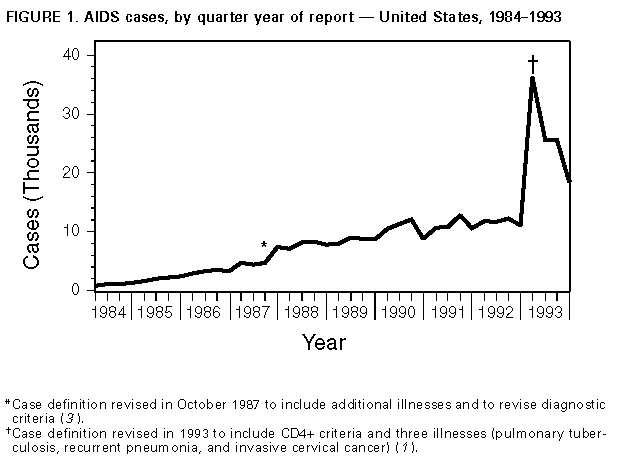 Return to top. Figure_2 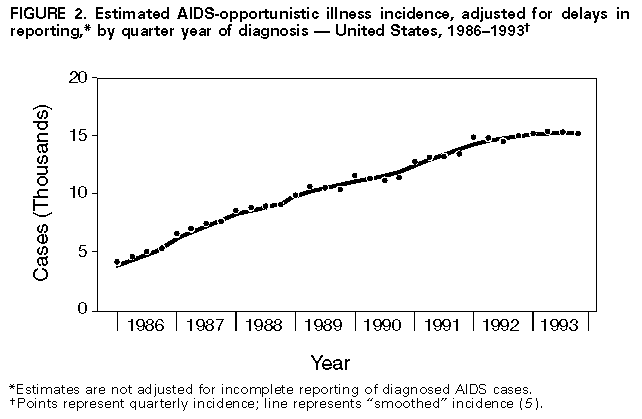 Return to top. Figure_3a 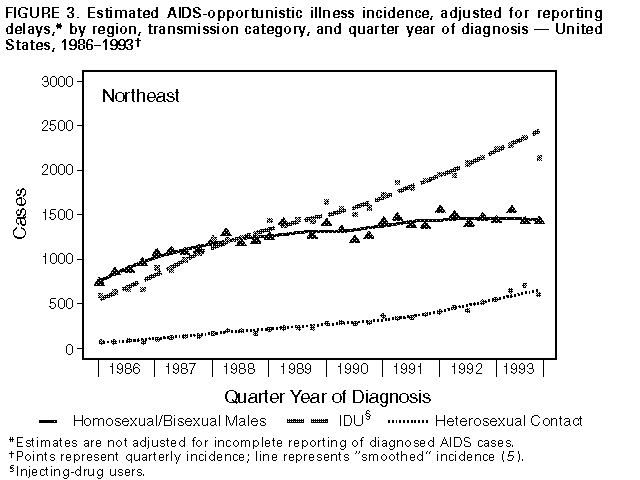 Return to top. Figure_3b 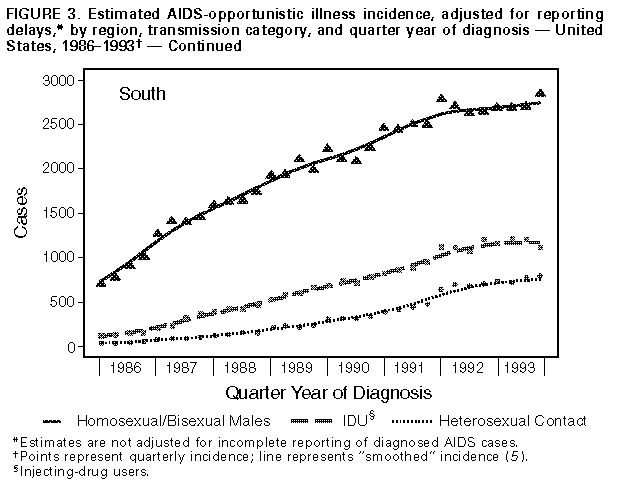 Return to top. Figure_3c 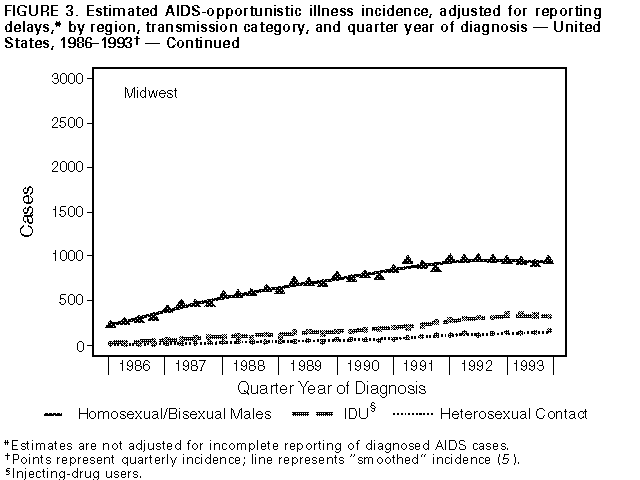 Return to top. Figure_3d 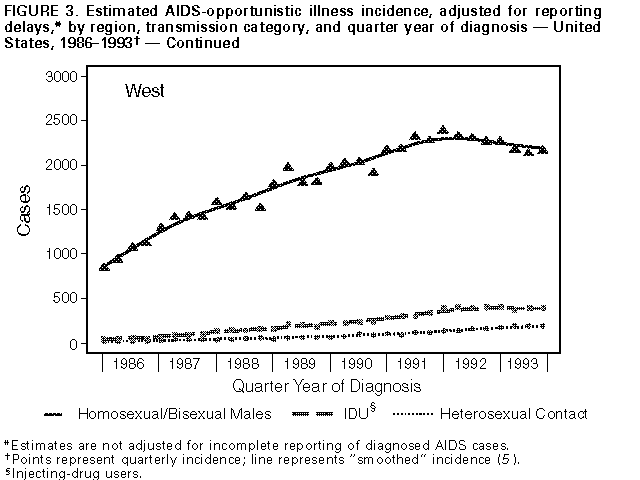 Return to top. All MMWR HTML versions of articles are electronic conversions from ASCII text into HTML. This conversion may have resulted in character translation or format errors in the HTML version. Users should not rely on this HTML document, but are referred to the electronic PDF version and/or the original MMWR paper copy for the official text, figures, and tables. An original paper copy of this issue can be obtained from the Superintendent of Documents, U.S. Government Printing Office (GPO), Washington, DC 20402-9371; telephone: (202) 512-1800. Contact GPO for current prices. **Questions or messages regarding errors in formatting should be addressed to mmwrq@cdc.gov. |
Source: http://www.cdc.gov/mmwr/preview/mmwrhtml/00033545.htm accessed on January 26, 2006.